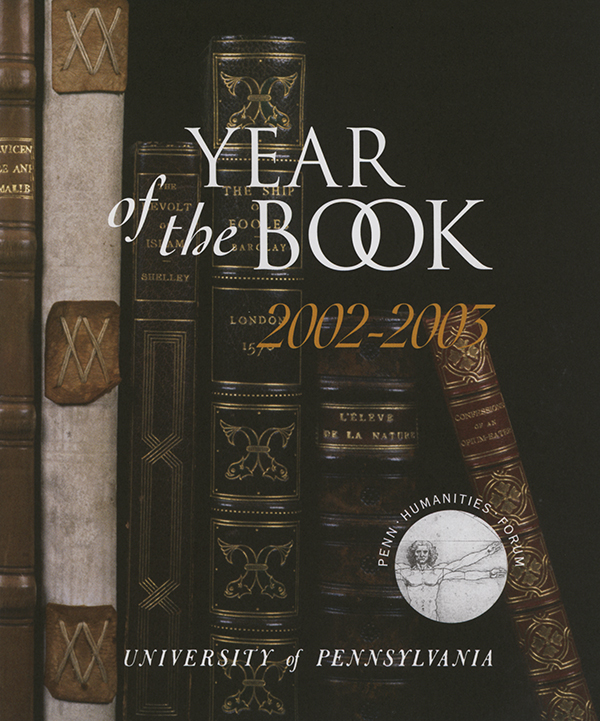Topic Director: Peter Stallybrass
Walter H. and Leonore C. Annenberg Professor in the Humanities
Professor of English
The Book has been the subject of innovative interdisciplinary work in the last two decades, becoming more visible the more its demise has been predicted. Will the book, which emerged as we know it in the first century of the Common Era, survive as an important cultural form in the third millennium? Does our present information overload make it less likely that we will store information in the bulky form of books, as opposed to in computers and on microfilms? Will new computer technologies make books as much the objects of nostalgia as gramophone records have become?
Anxieties about the disappearance of the book have made us increasingly aware of the central role that books of every kind play in our daily lives: picture books, telephone books, medical advice, restaurant guides, detective novels, self-help books, cookbooks, dictionaries, scholarly monographs, fashion magazines, bibles, computer manuals, date-books, city guides, and so on.
Perhaps books have tended to become invisible because they are so omnipresent that we take them for granted. But many of the features that we expect to find in books (title pages, word separation, page numbers, alphabetical indexes) were late developments as the book was adapted for different purposes and audiences. What are the most important changes that have taken place in the history of the book? The displacement of the scroll by the manuscript book? Word separation? Silent reading? The emergence of the printed book? Desktop publishing? Can some or all of these changes be described as revolutions?
The Penn Humanities Forum for 2002–2003 examined books as physical artifacts, cultural technologies, and sources of knowledge, devotion, and passion. We looked at the material surfaces of books (surfaces made from papyrus, rice, animal skins, rags, grasses, wood pulp) and at different forms of written and printed inscription (writing or painting with quills, brushes, or ballpoints; printing with wood blocks, hand presses, or laser technologies).
Do these different surfaces and methods of writing and printing shape or effect what has been written or printed? And who are the "authors" of the books we read? Scribes, patrons, publishers, the "authorities" upon whom a writer draws? When Roger Stoddard writes that "authors do not write books," he is not trying to make a theoretical point. He is reminding us that a printed book is not the product of an author's hand but of compositors, pressmen, proofreaders, and publishers, of papermakers and binders.
How is the material production of books related to a writer's inspiration? Do we need to rethink inspiration (meaning being breathed into) in relation to imitation, the dominant model of writing from Classical Antiquity to the Enlightenment? How are books marketed and distributed? (Penn owns a large collection of traveling salesmen's mock-ups, showing the different bindings, engravings, and even paper quality that a customer could order for the "same" book.) What differences have the .com companies made to the selling of books? How are books catalogued and stored in bookshops, warehouses, libraries, and in people's homes?
Renewed interest in the ways that books are made and marketed has also brought increasing attention to the reader, both in fiction (e.g., Borges, Calvino, Lessing) and in literary and cultural studies (e.g., Chartier, Darnton, Radway, Stock). How do the physical size, genre classifications, pricing, and marketing of a book affect the ways in which it is read? How do readers customize books for their own purposes? What can marginalia, bookmarks, and even wear and tear tell us about reading practices? One can, for example, find an extraordinary variety of markings in bibles: children's doodles, readers' signatures (sometimes repeated again and again, as if the reader was learning how to write his or her name); family trees; cross-references; notes by binders, booksellers, and librarians; paste-ins, including pictures, seals, clothing, even hair; corrections; criticisms; manuscript additions of other texts. How do book reviews (in magazines, newspapers, or professional journals) shape readers' desires and expectations?
Excellent new work is considering the intersections between literacy, reading, and power. Who receives access to books in the first place? Who is trained to read? Who is excluded from such training? Is writing an accomplishment, or is it, as was often conceptualized in Classical Antiquity and the Middle Ages, a mechanical art, subordinate to the oratorical skills of the elite? If books are a crucial form of cultural memory, who, then, decides what is to be remembered and how? How does censorship determine what is publishable? How, on the other hand, have prisons often been the place where the incarcerated acquire access to, and legitimation of, their writing?
Home
2002—2003



